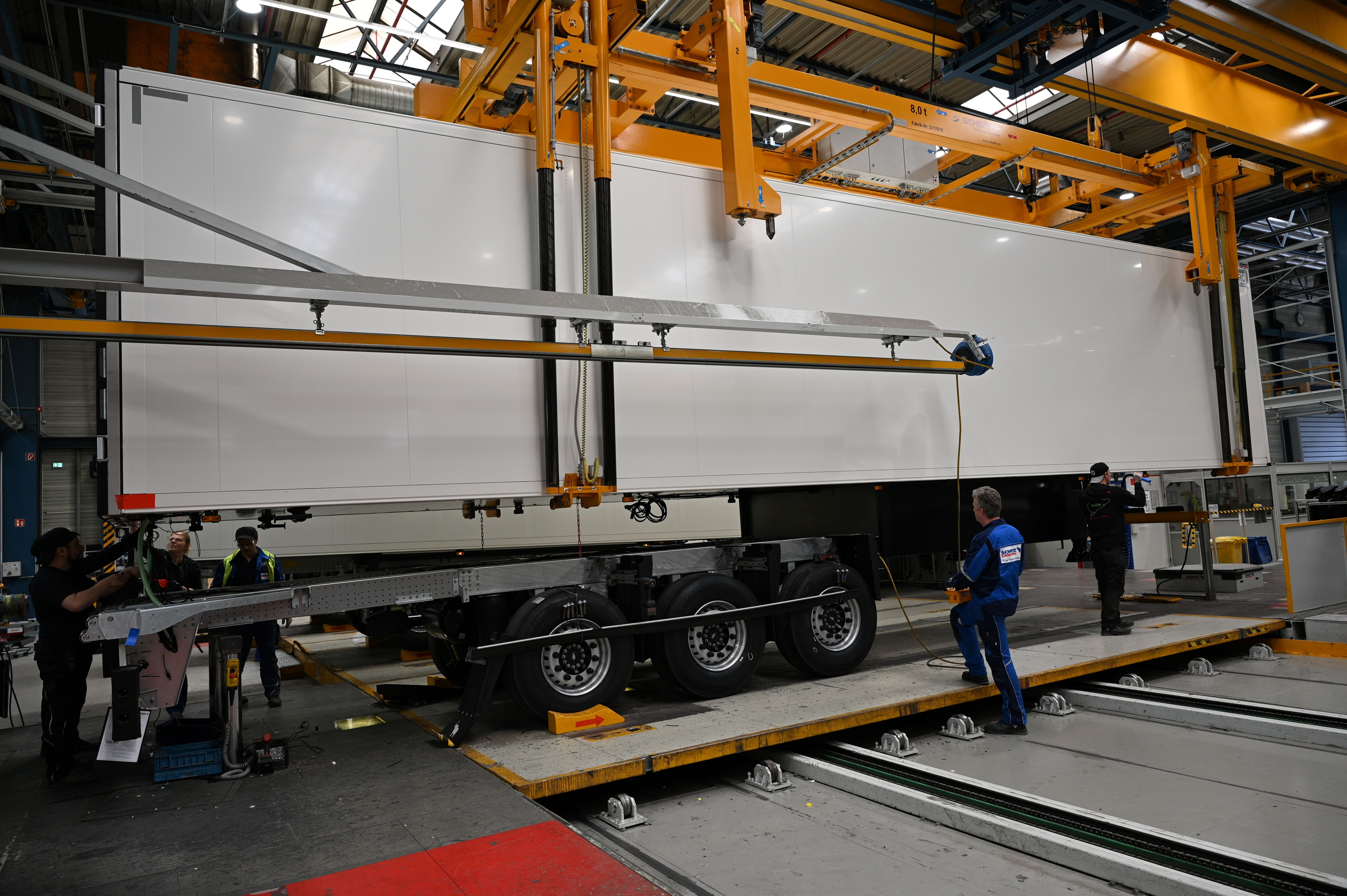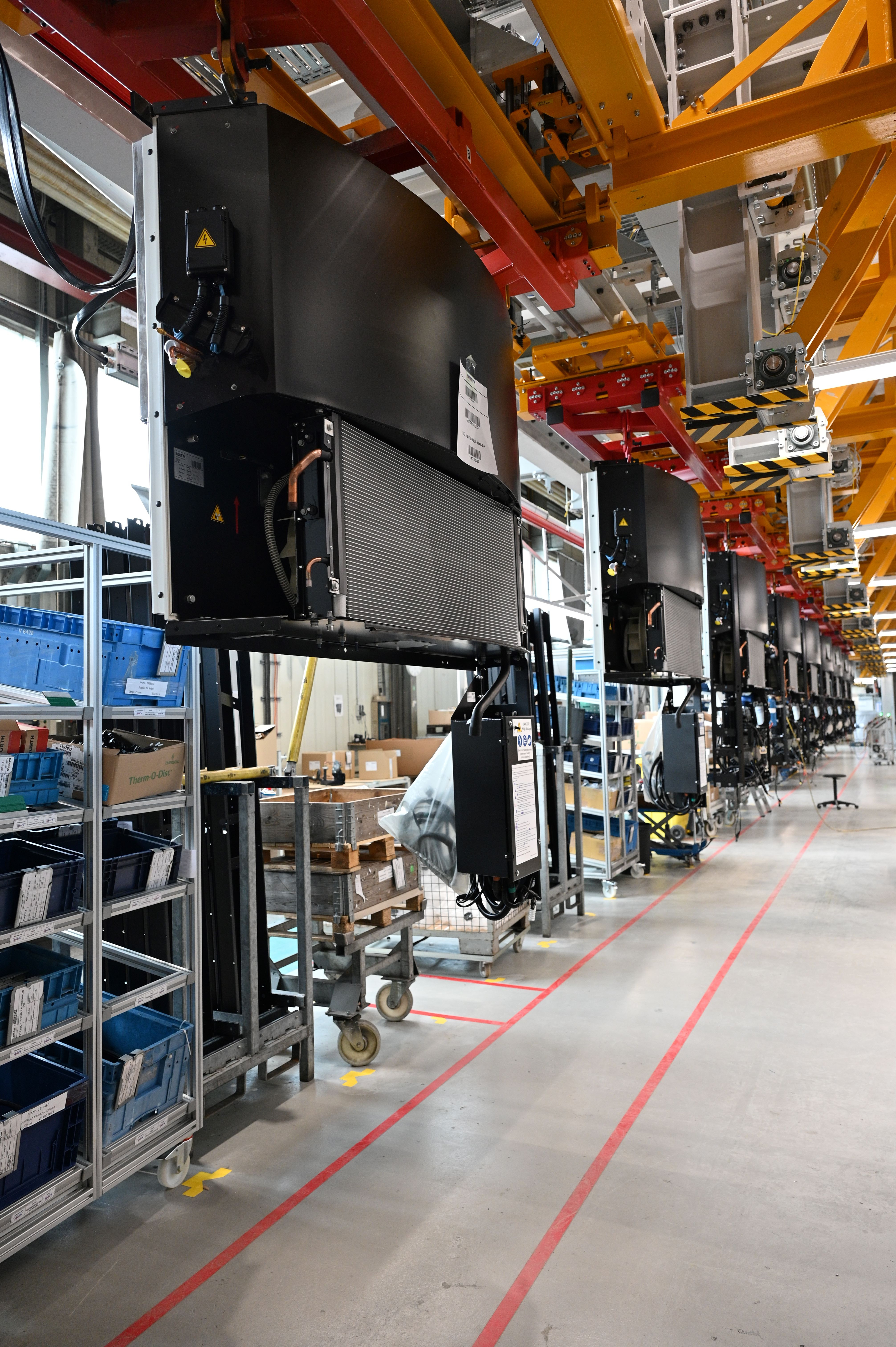Schmitz investing over EUR65m in “smart factory” at Vreden trailer site
By Bradley Osborne - 25th July 2024

Press conference at Schmitz Vreden plant
Germany – Between 12-13 June, Schmitz Cargobull AG hosted members of the press at its trailer factory in Vreden, located just on the border with the Netherlands. The ostensible reason for our visit was to receive a sneak preview of the company’s newest transport refrigeration product, which will be unveiled at the next IAA Transportation in Hanover: in fact, we learned much more about the company’s plans to expand and modernise its trailer factory, where it produces the ‘S.KO’ refrigerated models and the ‘S.BO’ dry freight range.
With support from the local government in the factory’s home state of North Rhine-Westphalia, Schmitz is investing over EUR65m (between 2021 and 2025) to build a 5,000-square-metre extension to the existing plant. In the new building, it will implement its vision of the “smart factory”: a highly automated assembly line with sensors and software collecting and analysing data to inform constant improvements to workflow. If successful, Schmitz’s “smart factory” in Vreden will serve as the template for future modernisations of its other plants. Though we were not shown inside the extension (see below for a narrative of the factory tour), we could see that the exterior is already finished, and work will continue inside the new building in preparation for an April 2025 opening date.
In the 2022/23 financial period, Schmitz achieved a turnover of EUR2,633m and a European market share (excluding the UK) of 26%. In that time, the company produced around 57,000 trailers. Admittedly, Schmitz trailer production is currently on a downward trend, from 60,807 in 2021/22 to a forecasted 45,500 in 2023/24. In the 2024/25 period, Schmitz predicts it will produce 40,000 units. Andreas Schmitz, CEO, said that high material, energy, and labour costs continue to impact production. Moreover, a fire at the Vreden plant led to a production setback of about seven to eight weeks.
Rising costs mean higher prices, and Schmitz admitted that the company has had to pass on the cost increases to its customers. He went on to a detailed critique of EU industrial policy, targeting its ever-growing regulatory regime. “We are losing our competitive edge,” he said, referring to the entire European industrial sector. The company is now actively lobbying for more “sensible” regulation to lift some of the burden off overstretched manufacturers.
With its gloomy economic outlook and increasing regulatory pressures, it is logical that Schmitz should be investing to squeeze as much out of its production sites as it possibly can. If the “smart factory” project works out as planned, Schmitz will be able to produce more trailers than before, and it hopes that such gains in efficiency will mean lower costs. This is how the German manufacturer is trying to remain competitive, in an environment which becomes more and more difficult by the day.
Expansion of capacity at the reefer factory in Vreden
The press tour took us round two factories: a larger facility in Vreden for refrigerated and dry freight trailers; and a smaller one in the nearby settlement of Gaxel, where Schmitz assembles its transport refrigeration units. The former is by far the more important site and fits TRUs of all makes onto the reefers, depending on the customer specification.

S.KO assembly at Vreden
Approximately 2,000 people work in the Vreden facility to produce around 21,300 trailers per year, equating to a new trailer every fifteen minutes. At the time of our visit, the plant was in fact running at a lower capacity than usual, with a two-shift work pattern for the reefer trailers but only one shift for the dry freight trailers. The production split is very uneven, at 90% reefers and 10% dry freight currently.
Firstly, we were shown the pre-assembly section of the factory, where the trailer roof, floor, and side walls are produced separately. The trailer floor, which is made primarily of plywood and aluminium, is assembled in layers: steel and foam make up the core, and each layer is stuck together with lots of glue (two hundred kilograms altogether!). The floor is then treated in a vacuum machine for three hours before a final coating is applied.
The floor is then taken to the assembly line, and even more glue is then applied to the perimeter. The workers then have fifteen to twenty minutes to fit the walls and rear doors on the floor before the glue sets. The walls are sealed to the floor with an automatic welder, and then the interior fittings and cabling are installed. After that comes the roof, more fittings, and then – for the reefers only – the TRU is installed. At the end, the body is assembled onto the chassis, at which point the trailer is ready to be finished and sent off.
Beyond the trailer production line, we saw the two foaming works where the ‘Ferroplast’ walls are made. Steel is unrolled and cut on an automatic line before being put through a hydraulic press. In two very large machines, the Ferroplast wall with its foam centre – sandwiched between two steel sheets – is made before being sent to the assembly line.
In an adjoining hall, we witnessed the chassis assembly, which takes place on a manual line split into workstations. The axles are sourced primarily from Schmitz’s factory in Altenberge: we were told approximately 95% of the trailer chassis made in Vreden have Schmitz axles.
The factory’s lean production methods were very much in evidence on the chassis assembly line, where the “kanban” system has been adopted for parts. We were told that lean manufacturing was introduced to Vreden in the last decade: each and every trailer is built to order or “just-in-sequence”.
With the EUR65m+ investment in Vreden, however, Schmitz aims to make its trailer production “smart” as well as lean. The new assembly hall will be more automated than the existing production line in order to reduce the cycle time per trailer from fifteen minutes to ten. With the added capacity, Schmitz aims to make up to 130 new reefers and 36 new dry freight trailers per day (supposing a three-shift work pattern). With the extra space and greater automation, Schmitz hopes to slash the amount of time it takes to produce each new reefer trailer from start to finish by around ten hours.

S.CU production at Gaxel
In Gaxel, Schmitz assembles TRUs not only for trailers produced at Vreden but also for Utility trailers made through its North American joint venture. (Around 15% of the TRUs made in Gaxel are destined for North America.) The small facility is split in two: there is a pre-mounting area with separate workstations, and another area for assembly. At the workstations, technicians put together the subcomponents – engines, generators, motors, and so on. These are then integrated with the unit on the assembly line. Depending on the shift pattern, between eleven and eighteen units can be produced per day.
Schmitz kickstarted development of its own TRUs back in 2007. By 2013, it had established series production of its first model, the ‘S.CU 1.0’. Today, Schmitz produces two diesel-powered TRUs: version 1.0 (not to be confused with S.CU 1.0), an “entry-level” option with a four-cylinder diesel engine; and version 2.0, the “premium” option boasting better performance and a lower total cost of ownership. In 2021, it launched its first fully electric TRU, the ‘S.CU ep85’. Over 30,000 Schmitz TRUs are currently on the road.


